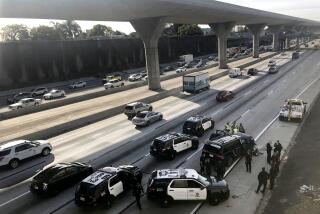A Venerable Car’s Big Sleep
- Share via
The gray Plymouth moved forward, gathered speed and darted around the corner onto Sunset Place. The sound of its motor died. . . .
I leaf through the pages of Raymond Chandler’s 60-year-old novel “The Big Sleep,” picturing the private detective Philip Marlowe working on a case, making his way around L.A. in the rain, gripping the huge steering wheel of his car.
I kicked my starter and drove on downtown to eat. I ate a good dinner. I drove north across the river, on into Pasadena, through Pasadena and almost at once I was in orange groves. The tumbling rain was solid white spray in the headlights. The windshield wiper could hardly keep the glass clear enough to see through.
My mind is awash with images. I see tailpipe exhaust spewing from a long automobile with running boards and broad bumpers. Cloudy inside with cigarette smoke, windows up. Radio off. A pistol in the glove compartment, or attached to a secret place underneath. High beams in dense fog.
My right front tire let go with an angry hiss. Before I could stop, the right rear went with it. I jammed the car to a stop, half on the pavement, half on the shoulder. . . . I had two flats and one spare.
Those damn Plymouths.
Letting a guy down this way.
*
I suppose if Marlowe were still taking on clients today, tailing a blackmailer, saving a dame, he would be doing it in a Plymouth Voyager van, with CD player and remote-control sliding door. It probably wouldn’t even have a cigarette lighter.
No gun under the dashboard, either. Just air bags.
They don’t make cars the way they used to. They certainly won’t make Plymouths the way they used to, because last Tuesday morning, after 71 years, the auto maker DaimlerChrysler announced that the once-proud Plymouth line would be permanently discontinued, sleeping the big sleep.
At one time in this country, a corner Plymouth dealership was as common a sight as a Sinclair gas station or a Woolworth’s five-and-dime. It was a household-word brand name as popular as Schlitz beer or Lifebuoy soap.
But how many Plymouth-only dealerships exist in America as of this week?
Three.
Back in the early 1960s, most Plymouths began to be sold on lots jointly with their sister Chrysler models. There are 2,956 dealerships in the U.S. that sell both makes, one of which looks exactly like the other. Anyone who can tell a Plymouth Breeze from a Chrysler Cirrus can also tell the taste of a red M & M from a green one.
How distinctive the Plymouth once looked. It was only natural that Stephen King chose a sleek 1958 Plymouth Fury for his title character in “Christine,” a story of a nerdy boy and a beat-up wreck he restores who, in the process, become cooler together. The fact that this Plymouth is also driven by some kind of inner demon brings a new meaning to the term “repossessed.”
Nevertheless, cool or un, I never owned a Plymouth myself and am not 100% positive that I ever rode in one.
Oh, sure, a long time ago somebody from the neighborhood was always peeling rubber in a cherry Plymouth Road Runner--
probably in 1973, when sales of Plymouth cars hit an all-time high of 742,991.
A quarter-century later, Plymouth would sell only around 307,000 of its 1998 cars. Its presence outside the United States was practically nil, and its sales in Canada had gone as flat as Marlowe’s tires.
Where, oh where, did poor Plymouth go wrong?
I can’t remember the last time anyone mentioned one to me in conversation. And I’m not merely speaking of California, where a Plymouth is about as common a sight as a blond with blond roots.
Years ago, somebody’s dad drove a sporty Valiant while his son’s first car was an ugly but dependable Duster. Nowadays, though, you stand a better chance of spotting a coyote on a road than a Plymouth.
Through 2001, only two Plymouth models will be sold. One is the nondescript Neon. The other is a fabulous hot rod called the Prowler that looks as if it were driven by John Travolta in “Grease” but is actually so expensive that Travolta is among the few Americans today who can afford one.
*
Across the street, a hundred feet up, a gray Plymouth sedan was parked. It was the same one that had tried to trail me around the day before, the same one I had asked Eddie Mars about. There might be a cop in it. . . .
There were Plymouths everywhere he looked, back in Marlowe’s day.
The Plymouth was across the way at a fireplug. I reached it and jerked open the door on the curb side. A small bright-eyed man was pressed back into the corner behind the wheel. . . .
He swallowed and the cigarette bobbed between his lips. “I don’t think I know you,” he said.
“Marlowe’s the name. The guy you’ve been trying to follow around for a couple of days.”
“I ain’t following anybody.”
“This jalopy is. Maybe you can’t control it.”
I close my book. I pick up my Sunday newspaper and look for the Plymouth ads. Perhaps I will go out and buy one. You know, for the road.
*
Mike Downey’s column appears Sundays, Wednesdays and Fridays. Write to him at Times Mirror Square, Los Angeles, CA 90053. E-mail:






